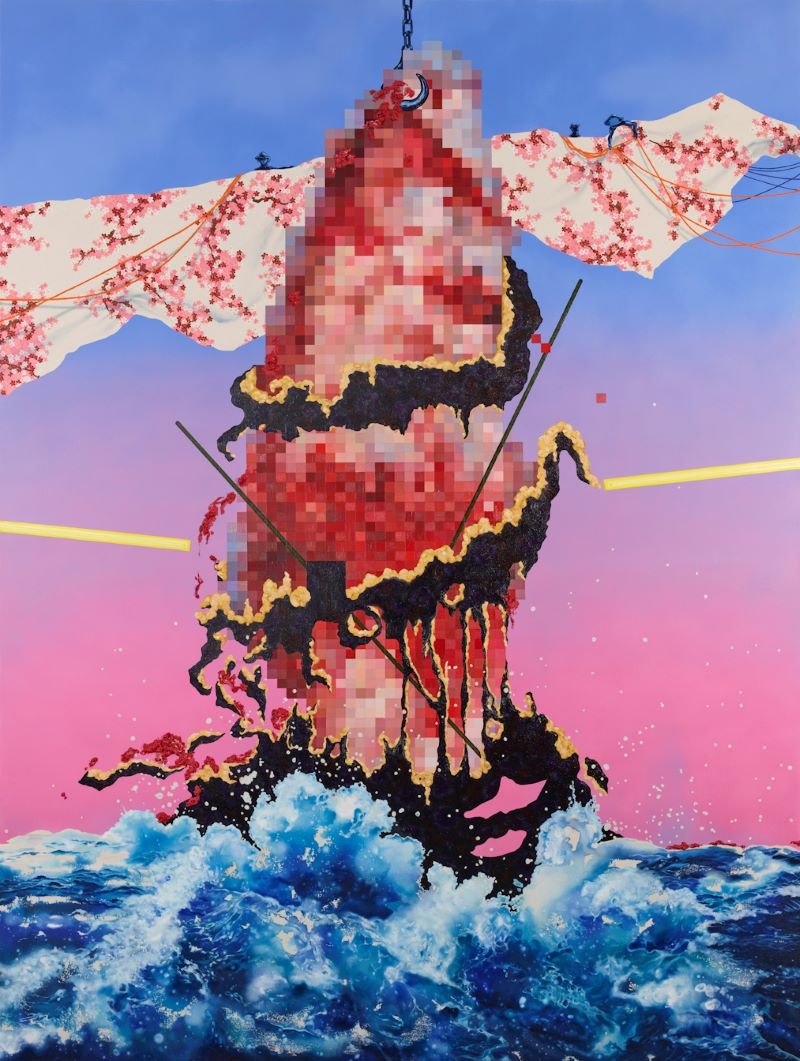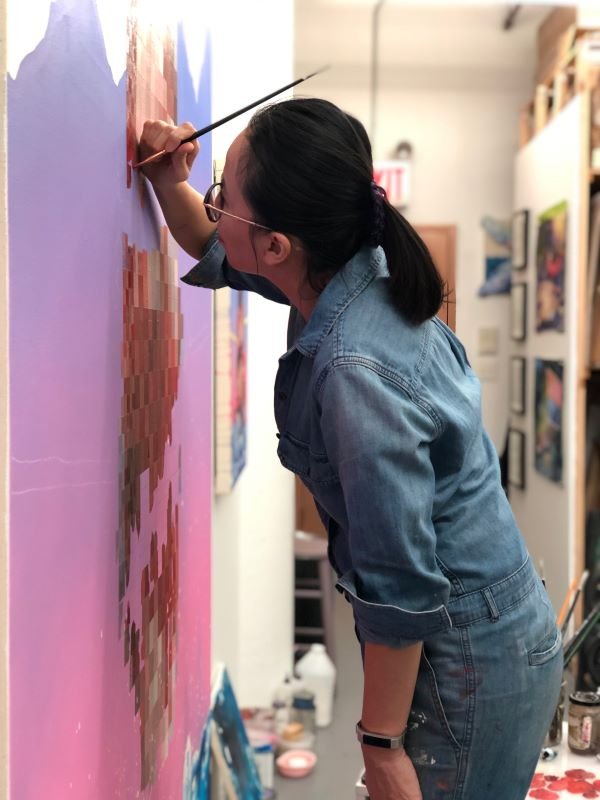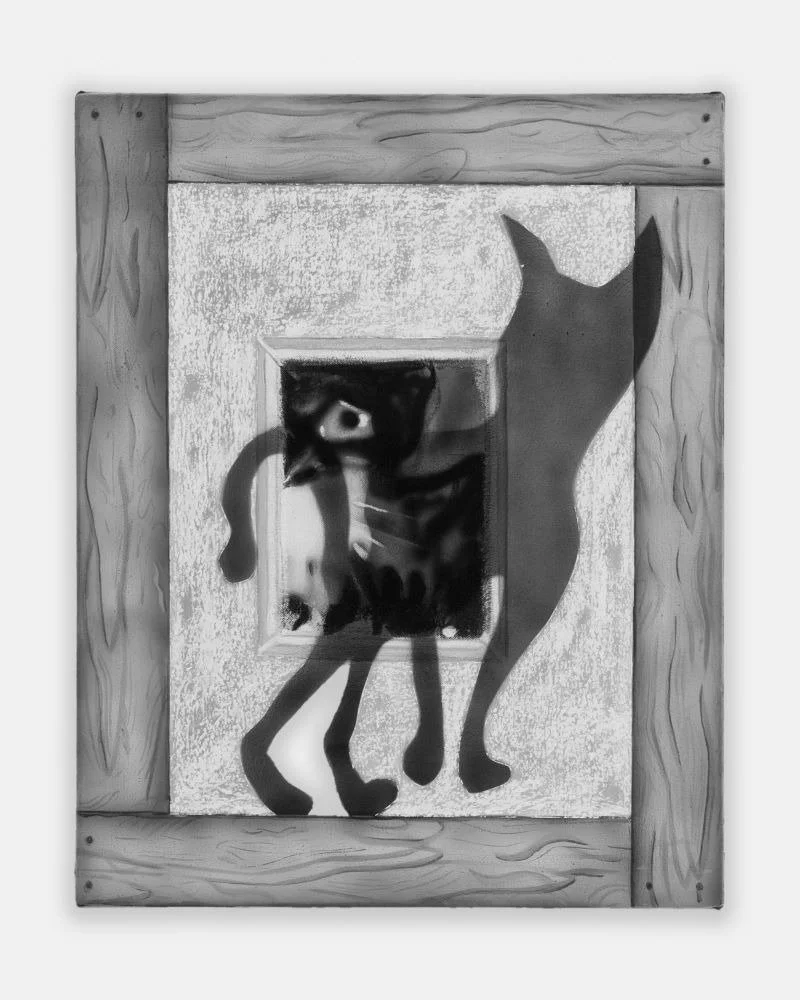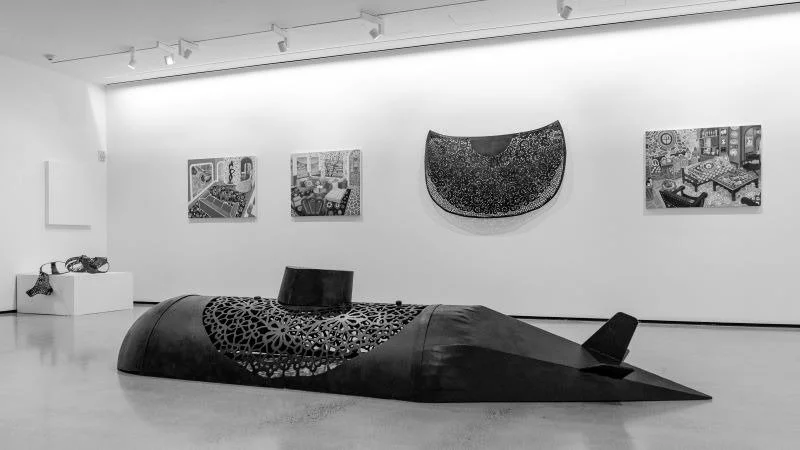ELEEN LIN'S whimsical mistranslations
“Blanket”, 2019 - Oil and acrylic on canvas - 96 x 72in. (243.8 x 182.9cm)
A “third culture” kid, Eleen Lin was born in Taiwan but grew up in Thailand with a Western education. In the age of cultural cannibalism where everything is brought together and rearranged to formulate new identities, she reiterates folklores and classical literatures into contemporized cross-cultural narratives.
At New York’s C24 Gallery, Lin is currently a part of their Mythodical exhibition (on display through May 4, 2022). Lin is showing works from her series Mythopoeia, a nearly decade-long project investigating the unlikely results of a series of mistranslations between English and Mandarin versions of the classic novel, Moby-Dick. Her works are paired with sculptures by African-American ceramic artist and educator Tammie Rubin. Rubin’s fantastical totemic objects are created from ubiquitous forms found in the visual language of modern consumer culture.
Both artists explore the evolution of myths that emerge through total immersion in mainstream narratives, their vision manifested through a deeply methodical and detailed creative process. Their respective identities offer additional layers of perspective about both the immigrant and ethnic minority experience in the United States, and how essential these points of view are to developing truths that cross both time and geographic boundaries. Together, their work points to a shift away from a culture that centers the majority experience and designates all other perspectives as “other,” while providing fascinating commentary on some of modern society’s most cherished myths and traditions.
Interview by Interlocutor Magazine
Your series Mythopoeia is a nearly decade-long project. How did it evolve into such a substantial undertaking? Did you initially set out to create an ambitious large-scale thematic project, or did it develop more gradually/organically?
Before the Mythopoeia series I was working on another series titled Pet Society for five years. These paintings repositioned narratives of mainly Chinese folklores into stories of urbanites’ relationship and obsession with their pets. I began Mythopoeia a series inspired by Moby-Dick in 2014. I found many elements in this piece of classic American literature relate to my experience as an immigrant artist: the cultural diversity of the crew-mates, the search for the meaning of life away from homeland, the mysticism of travel, and the journey from the US to Asia.
I also questioned why Moby-Dick was never really widely recognized in the Chinese speaking world and in fact the majority of the people I spoke to thought it was the “Old Man and the Sea”. This prompted me to read the Mandarin translation of the novel and this is what began this long journey of recreating the story through mistranslations and contemporizing it with new interpretations.
I originally thought Mythopoeia was going to take around five years to complete, but it has spanned out way more than anticipated. The more I go back to the original text and the mistranslations the more I am inspired by its impactful symbolism, allegories and cultural misunderstandings.
These meanings and interpretations tend to shift with the changes in social, political and environmental condition of our times. Which is why the project continues to grow organically. Currently I have a long list of paintings that I know I’ll be making for this series, and I know this list will grow as I’m working through them. Obsession plays a big part in Moby-Dick, and I feel this book has definitely captivated me in that way.
“Perils of Life”, 2022 - Oil and acrylic on canvas - 72 x 96in. (182.9 x 243.8cm)
What do you think are some specific cultural differences that caused all of the Chinese mistranslations of Moby-Dick? Is it possible that some mistranslations may have even added unexpected/unintended layers of meaning or even unique enhancements to the text?
The main reason for the mistranslation lies in the lack of whaling culture and history in China or Taiwan, so a lot of the whaling lingo did not have direct vocabularies that correspond to them. On top of that there was only one translation of the novel that was published in 1957, and all latter translations that were published are all reformatted from this first translation. (A newly translation version was published in 2019). Since these translations were reworked not from its original source, and the fact that some versions even took out certain chapters the publisher found irrelevant to the overall story, a lot of content was lost.
Moreover, Melville’s writing is often poetic and to translate that language without breaking the original sentence structure to fit the grammatic construct in Mandarin results in a “Google” like format of translation.
These mistranslations inspired me to dwell on cultural indexes that have shifted and the humor that arises due to linguistic and cultural indifferences. They often add unintended layers of meanings, but also showcase how our cultural background changes the way we understand parts of the story. I find the mistranslations enhance the open-ended context that are embedded in the paintings.
“Fluke”, 2021 - Oil and acrylic on canvas - 36 x 24in. (91.4 x 61cm)
You have a very methodical approach to creating these works – you've said before that you go from pencil sketch to watercolor study to a small painting before embarking on the large-scale final work. What appeals to you about this approach? Does it get you into a certain state of mind or concentration needed for the work?
Yes, while reading the book I make sketches of ideas and elements that automatically popped into my head. These sketches are then reworked several times until it forms its own story. I would then create a watercolor painting base on the sketch so I can figure out the color. A smaller painting on canvas usually 28” x 36” would then follow to assist with the development and pre-planning on the steps of layering for the final 7’ x 8’ painting.
I developed this process after years of trying out different methodologies. It is essential for me to go through these stages to find a balance between conceptual and compositional/ formal elements. Each phase helps me to understand what will work best for the scale of the work and whether I needed to add new layers and features into the final composition. The 7’ x 8’ paintings usually take around 3 - 4 months to complete, and I always add new imageries into the picture during the process of painting due to the large scale. This gives the painting a collage-like effect, and I like to flood the painting with different imageries to simulate what we experience in the digital world, where multiple representations and images pop on to the same screen and reproduce the feeling of an excess of information.
“Phantom of Life”, 2019 - Oil and acrylic on canvas - 48 x 72in. (121.9 x 182.9cm)
Especially with Mythopoeia, you have an almost literary approach that resembles an author working through multiple drafts of a text. Authors often struggle with knowing when a text is “done” and ready – do you ever struggle with doubt like that? What gives you a sense that a painting is fully “edited” and ready for “publication,” so to speak?
Since I rework these images through so many steps and “editions” the familiarity I have with the composition will tell me directly when the work is complete. I will know if something is missing in a certain part of a painting due to the imbalance, and once no additional information can be added to the canvas, I know the work is done.
“Strange Shapes of the Unwarped, Primal World”, 2022 - Oil and acrylic on canvas - 72 x 96in. (182.9 x 243.8cm)
Could you talk about how you believe Mythopoeia works in conversation with Tammie Rubin's ceramic sculptures in C24's Mythodical exhibition? How do you think her sculptures and your paintings complement each other and may also add unexpected tensions or layers to each other when placed together in the same space?
David C. Terry and the team at C24 Gallery have done such a great job pairing Tammie’s work with mine. It is not only through our subject and ties with myths in contemporary culture, but the color palette and forms in her sculptures really echoes my works. Some of her sculptures look like details of my paintings and placing them together really draws the eyes closer to find elements that are present in both my work and hers.
Eleen Lin’s work paired with sculptures by Tammie Rubin - Mythodical exhibition, C24 Gallery
Mythodical will be on display at C24 Gallery, Chelsea, through May 4, 2022
View more of Eleen’s work on her site and Instagram
Images courtesy of Eleen Lin and C24 Gallery












